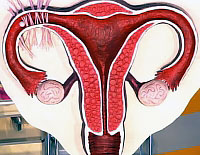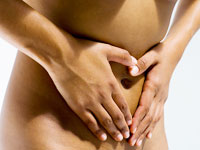SalpingoForit, adnexitis: reasons, risk factors, manifestations. Diagnosis and treatment of inflammation of appendages.
Content
 Inflammation of appendages (SalpingoForit, or adnexitis) — This is the inflammation of uterine (phallopy) pipes and ovarian. Most often, the infection falls into these organs as rising from the vagina and the uterine cavity, hitting the uterine tube first, and then the ovary. It is usually a bacterial infection (streptococcal, echerychoid), often from those are transmitted by sexual path (trichomoniasis, gonorrhea, chlamydia). It follows from this that the frequent change of sexual partners, neglect contraception increase the risk of disease. The same should be said about intrauterine interventions, including abortions, formulation of intrauterine spirals. A hematogenous path of infection is possible, in which the pathogen falls into the appendages of the uterus through blood. This happens with a decrease in immunity, generalized infection, the presence of chronic purulent foci in the oral cavity, almonds, incomplete sinuses.
Inflammation of appendages (SalpingoForit, or adnexitis) — This is the inflammation of uterine (phallopy) pipes and ovarian. Most often, the infection falls into these organs as rising from the vagina and the uterine cavity, hitting the uterine tube first, and then the ovary. It is usually a bacterial infection (streptococcal, echerychoid), often from those are transmitted by sexual path (trichomoniasis, gonorrhea, chlamydia). It follows from this that the frequent change of sexual partners, neglect contraception increase the risk of disease. The same should be said about intrauterine interventions, including abortions, formulation of intrauterine spirals. A hematogenous path of infection is possible, in which the pathogen falls into the appendages of the uterus through blood. This happens with a decrease in immunity, generalized infection, the presence of chronic purulent foci in the oral cavity, almonds, incomplete sinuses.
Factors predisposing to the development of inflammation of appendages:
- supercooling;
- Foci of chronic infection;
- diseases of the urogenital system;
- Endocrine disorders;
- indiscriminate sex life;
- Reduced immunity, stress, smoking.
Signs of inflammation of the appendens
The development of acute inflammation is evidenced by severe pain at the bottom of the abdomen, more often on the right side, impaired urination, discharge from the vagina and typical signs of intoxication: fever, headache, Malgy, general weakness. It is necessary to refer to the gynecologist as early as possible. Spontaneous sacrament of symptoms does not mean recovery. The process can go into a chronic form. Pains become pulling, non-permanent, they are enhanced after supercooling, sexual intercourse, overwork, with colds. Gradually disrupts the function of the ovaries and uterine pipes due to the formation of adhesions of the fights or due to the purulent melting of the tissues. This manifests itself in a hormonal imbalance, a menstrual cycle is disturbed (menstruation becomes long and abundant, painful, or, on the contrary, short, with a small amount of selection). Iniquity or immobilization of the uterine tube make it impossible to capture and conclusion in the uterine eggs, that is, lead to infertility.
Diagnosis and treatment of inflammation of appendages
 In diagnostic purposes, a gynecological study is carried out, the smear fence on the vagina microflora, ultrasound of appendages. The highest diagnostic value in chronic adnexite has laparoscopy, during which it is possible to see the changes that occurred with appendages. The study of the hormonal profile helps to identify endocrine disorders associated with disorders of the ovary. Treatment begins with the appointment of antibacterial drugs, which are chosen, taking into account possible pathogens. As a rule, these are antibiotics from a group of penicillins and cephalosporins, sulfonamides. As an additional treatment, anti-inflammatory, painful, immunostimulating agents are used. Under the election of inflammation, efforts are sent to the elimination of the adhesive process: carry out physiotherapy (ultrasound, electrophoresis, diathermy), use injections of absorbing spikes of drugs, hormonal contraceptive courses. In the development of complications (hydraulpinx, inflammatory tubarous conglomerate, tubarous abscess) Necessary treatment.
In diagnostic purposes, a gynecological study is carried out, the smear fence on the vagina microflora, ultrasound of appendages. The highest diagnostic value in chronic adnexite has laparoscopy, during which it is possible to see the changes that occurred with appendages. The study of the hormonal profile helps to identify endocrine disorders associated with disorders of the ovary. Treatment begins with the appointment of antibacterial drugs, which are chosen, taking into account possible pathogens. As a rule, these are antibiotics from a group of penicillins and cephalosporins, sulfonamides. As an additional treatment, anti-inflammatory, painful, immunostimulating agents are used. Under the election of inflammation, efforts are sent to the elimination of the adhesive process: carry out physiotherapy (ultrasound, electrophoresis, diathermy), use injections of absorbing spikes of drugs, hormonal contraceptive courses. In the development of complications (hydraulpinx, inflammatory tubarous conglomerate, tubarous abscess) Necessary treatment.









